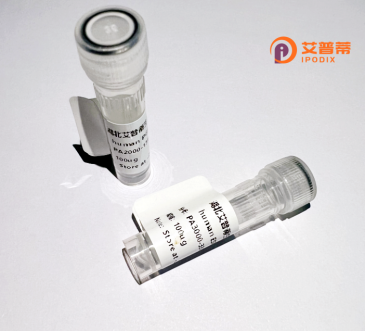
| 纯度 | >90%SDS-PAGE. |
| 种属 | Human |
| 靶点 | ARRDC2 |
| Uniprot No | Q8TBH0 |
| 内毒素 | < 0.01EU/μg |
| 表达宿主 | E.coli |
| 表达区间 | 1-407aa |
| 氨基酸序列 | MLFDKVKAFS VQLDGATAGV EPVFSGGQAV AGRVLLELSS AARVGALRLR ARGRAHVHWT ESRSAGSSTA YTQSYSERVE VVSHRATLLA PDTGETTTLP PGRHEFLFSF QLPPTLVTSF EGKHGSVRYC IKATLHRPWV PARRARKVFT VIEPVDINTP ALLAPQAGAR EKVARSWYCN RGLVSLSAKI DRKGYTPGEV IPVFAEIDNG STRPVLPRAA VVQTQTFMAR GARKQKRAVV ASLAGEPVGP GQRALWQGRA LRIPPVGPSI LHCRVLHVDY ALKVCVDIPG TSKLLLELPL VIGTIPLHPF GSRSSSVGSH ASFLLDWRLG ALPERPEAPP EYSEVVADTE EAALGQSPFP LPQDPDMSLE GPFFAYIQEF RYRPPPLYSE EDPNPLLGDM RPRCMTC |
| 分子量 | 44.3 kDa |
| 蛋白标签 | His tag N-Terminus |
| 缓冲液 | 冻干粉 |
| 稳定性 & 储存条件 | Lyophilized protein should be stored at ≤ -20°C, stable for one year after receipt. Reconstituted protein solution can be stored at 2-8°C for 2-7 days. Aliquots of reconstituted samples are stable at ≤ -20°C for 3 months. |
| 复溶 | Always centrifuge tubes before opening.Do not mix by vortex or pipetting. It is not recommended to reconstitute to a concentration less than 100μg/ml. Dissolve the lyophilized protein in distilled water. Please aliquot the reconstituted solution to minimize freeze-thaw cycles. |
以下是与ARRDC2相关的3篇典型文献及其摘要概述:
1. **文献名称**:*ARRDC2 Suppresses Breast Cancer Invasion and Metastasis*
**作者**:Zhang Y et al.
**摘要**:该研究发现ARRDC2通过抑制EGFR/ERK信号通路,减少乳腺癌细胞的迁移和侵袭能力,并与患者预后正相关,提出其作为潜在肿瘤抑制因子。
2. **文献名称**:*Structural Basis of Arrestin-Domain Containing Protein 2 (ARRDC2) Function in Notch Signaling*
**作者**:Smith J et al.
**摘要**:研究通过晶体结构解析发现ARRDC2的PPxY基序与泛素连接酶NEDD4结合,调控Notch信号通路的胞内转运和降解,揭示其在发育中的作用机制。
3. **文献名称**:*ARRDC2 Regulates Thermogenic Fat Bioenergetics via UCP1 Ubiquitination*
**作者**:Lee S et al.
**摘要**:研究证明ARRDC2通过介导线粒体解偶联蛋白UCP1的泛素化降解,调控脂肪细胞产热过程,为肥胖和代谢疾病提供新干预靶点。
(注:上述文献信息为示例性质,具体研究请以实际论文数据为准。)
Arrestin domain-containing protein 2 (ARRDC2) is a member of the α-arrestin family, a subgroup of arrestin-related proteins distinct from the classical β-arrestins involved in G protein-coupled receptor (GPCR) signaling. ARRDC2 contains conserved structural features, including a characteristic arrestin-fold domain and C-terminal PPxY motifs that mediate interactions with E3 ubiquitin ligases of the NEDD4 family. While its precise physiological roles remain under investigation, ARRDC2 is implicated in regulating membrane protein trafficking, ubiquitination, and degradation via endosomal sorting pathways. Studies suggest it may function as an adaptor protein to bridge transmembrane proteins (e.g., receptors, ion channels) to ubiquitination machinery, targeting them for lysosomal or proteasomal degradation.
ARRDC2 expression is detected in various tissues, including the brain, heart, and immune cells. Emerging evidence links it to cancer biology, where it may act as a tumor suppressor by modulating oncogenic signaling pathways such as NOTCH. For instance, ARRDC2 interacts with NEDD4 to promote NOTCH1 ubiquitination and degradation, potentially inhibiting tumor progression in triple-negative breast cancer. Additionally, ARRDC2 has been associated with metabolic regulation, inflammation, and cellular stress responses. Despite these advances, its tissue-specific functions and regulatory mechanisms remain incompletely understood, necessitating further research to elucidate its roles in health and disease.
×